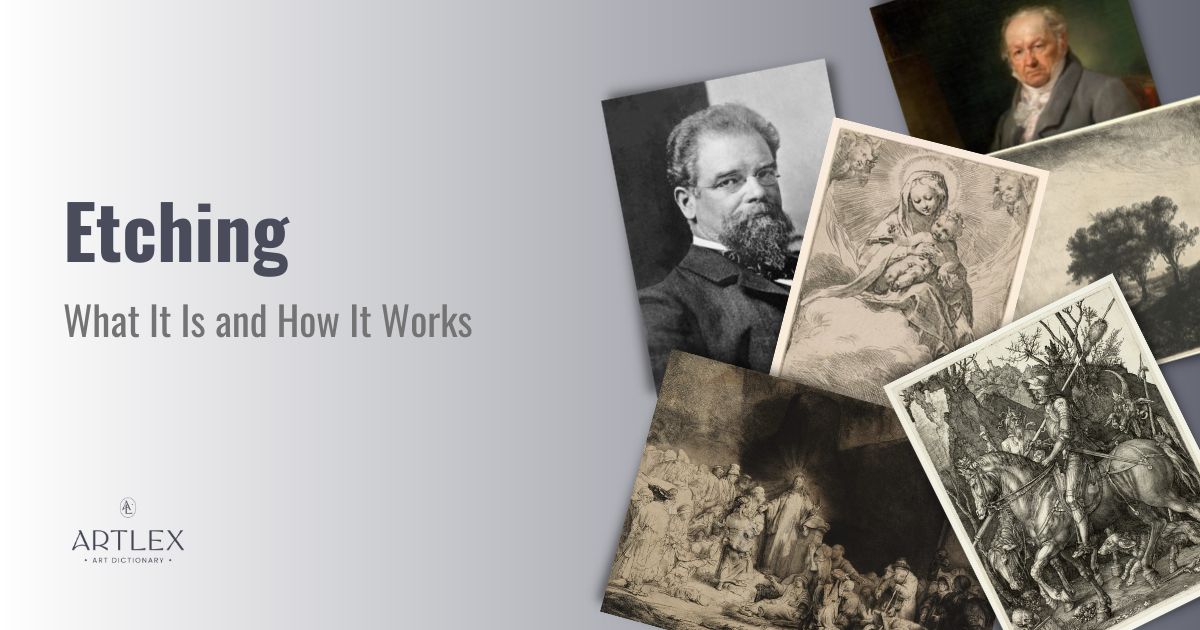
Have you ever been enchanted by etching art masterpieces by Rembrandt, Pablo Picasso, or Francisco Goya? Then, keep reading to uncover the traditional processes of the hard-working charm behind the traditional etching of Intaglio printmaking.
What Is Etching?
Etching means imprinting an image on a piece of metal using acid. The resulting metal plate is used for printing by spreading ink across it and pressing it against paper.
First, the artist covers the metal surface with acid repellent. Then, they carve the design with an etching needle, which removes those parts of the repellent. After this step, acid is spilled over the metal plate. The piece is cleaned up and the plate is ready for inking.
Intaglio engravings carve incisions into copper plates spilling ink onto paper or cloth under the heavy press, also known as the Intaglio printmaker or etching press.
The traditional form of etching uses copper plates, but sometimes artists chose to use zinc, brass, or silver metal plates instead to create raised edges without metal residue.
Unlike woodcut, engraving, and lithography, etching employs acid or etchant to create seamless line depth and control tone, and removes any trace of exposed metal remnants.
The History of Etching
The first sign of the etching technique appeared in 1513 when Swiss goldsmith Urs Graf etched the earliest dated prints of a Woman Bathing Her Feet.
Although there is no credit due for the first ever etched artwork, the English military under Henry 8 etched an armory that can date back to 1511. However, in the same way, many etched armor suits can be traced to German craftsman Daniel Hopfer.
As the process proved more economical and accessible, apprentices under Hopfer, like Urs Graf, continued the trade producing breathtaking etches like the printed etch ‘Devil Captures Soldier.’
16th-Century Printmaking
In the 16th century, Germany set the stage for German Renaissance painter and printmaker Albrecht Duerer. Despite exploring subjects of European folklore, religion, and history, Duerer remains a prodigy of his time.
And rightfully so, under the guise of his goldsmith father, Albrecht Durer the Elder and woodworker Michael Wolgemut process many significant publications. After Durer’s epiphany, his engravings of Adam and Eve, Meisterstiche, Man or Sorrows, and Agony in the Garden demonstrate impeccable technique and deep spiritual interest in wondrous works of art.
His talents put him at the doorstep of German influencers as the ordained artist to Holy Roman Emperor Maximilian 1. Printmakers could find Durer’s prints across Northern Europe in Germany, Italy, and the Netherlands.
17th-Century Printmaking
At the start of the 17th century, apprentices of French baroque printmaker Jacque Callot and French artist Abraham Bosse traveled throughout Europe with the Manual of Etching in 1645. The manual includes etching methods, blueprints to build a press, and accessible tools that anyone within the vicinity of English, Dutch, Italian, and German speakers can access.
However, Rembrandt van Rijn remains well known for over 300 etchings, such as The Artist’s Mother, The Good Samaritan, and Abraham and Isaac.
After the emergence of the intaglio process, the style evolved to combine a resume of etching variations, such as combing the drypoint method with aquatint techniques that would inspire 20th-century printmakers to follow their creative inclinations making the initial printmaking methods challenging to follow.
Variations of Etching
After artists worldwide discovered the magic of etching, variation in method and technology helped them produce prints that created never-before-seen tonal, textural, and sharp effects.
In general, there are two styles of etching: dry and wet. Dry etching incorporates gaseous chemicals and plasma to remove the ground. Wet etching uses a liquid chemical to peel back the surface and reveal the etch pattern and background areas. However, there are more printmaking techniques than meets the eye.
Aquatint
Although aquatint printmaking derives from the intaglio school of technique, it rarely creates textual lines. Instead, acquaint applications utilize the recessed areas to create tonal effects that add depth and gradation to the plate surface.
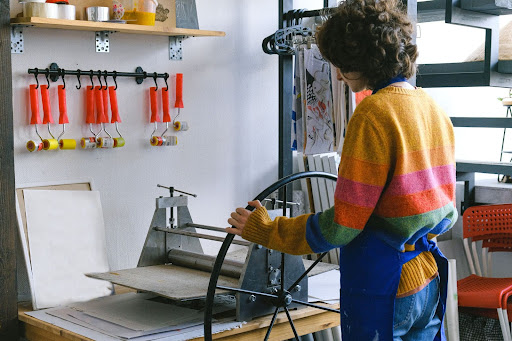
Printmakers apply acid-resistant ground with heat and bathe the iron plates in acid for the desired length to produce miniature engraved ringlets and incised lines bitten to perfection.
Beautiful aquatint etching styles include Allan Osterlin’s Flamenco Dancer and Goya’s #20 from the Tauromaquia series.
Soft Ground
Soft ground etching, derived from intaglio, applies a soft, fatty, or waxy ground to the metal plate and then dips it in a chemical bath to expose the metal. Not only does this technique reveal a variety of textures with soft incised lines, but it also creates a soft, eerie, or angelic ambiance to the design. In addition, to its pencil passes and hand-drawn appearance.
Printmakers usually melt or brush a thin layer of soft ground like beeswax, vegetable oil-infused resin, or an animal fat like tallow to get this effect. Then, after the artist applies the soft ground to a well-prepared surface and waits for the fat to be soft to the touch, the plate is ready to be bitten by the acid.
However, instead of using damp paper to protect the etch from the press as a hard ground etching, the soft ground will require a grease-proof piece of paper with light pressure to ensure the print doesn’t undergo damage.
You can find a reference in Rembrandt’s Self-Portrait, Leaning on a Stone Sill.
Drypoint
Drypoint intaglio printmaking uses a sharp diamond-tipped needle to cut through the metal printing plate– creating crisp lines and feathery edges without using acid, just ink. Thus, placing the technique in the school of intaglio printmaking methods.
After the coves the plate, the plate is wiped clean, only leaving behind ink in the incisions. Then, the plate goes under the printing press. It is important to note that the print press plays a significant role in transferring your design seamlessly onto the paper due to the absence of acid-eroding chemicals.
Notable drypoint etches include Edvard Munch’s Two people, The lonely one, Max Beckmann’s Self-Portrait in Bowler Hat, and Pablo Picasso’s Portrait of Olga in a Fur Coat.
Mezzotint
Mezzotint is a very unique intaglio method because it involves carving a texture into the whole metal plate and then smoothing out certain areas. Artists use a tool known as a rocker, which has a circular, small-toothed edge; they methodically apply pressure to the copper plate with it until the surface has a rough texture.
That texture holds the ink perfectly. Then, using other carving tools, the artist smoothes out the parts of the plate that they want to hold less ink. So, the heavily-textured sections will be black, and the smoother parts will be a lighter grey.
The plate is then inked and cleaned with a cloth until there is only the desired amount of ink. The paper can then be pressed against it and printed.
Mezzotint is a 17th-century English monochromatic technique that is rarely applicable without other methods, such as dry point etching, due to its ability to contrast heavenly gradations of light tones and smooth black shadows.
You can see mezzotint at its finest by referencing Georges Francois Blondel’s A View of the Vestibule of Santa Maria Maggiore at Rome and A Woman Peeling Pears by Wallerant Vaillant.
Chine Colle
In Chine Colle, various pieces of colored or textured paper are placed between the plate or stamp and the paper that is to be printed. The artist places the paper pieces in different areas of the plate, so the result is similar to a print with a collage background.
Chine Colle is well-known for integrating imported tissue-thin, linen, Japanese, or rice paper from China, Inda, and Japan into the intaglio printing technique. In addition, the technique prints on paper textured or colorful paper bonded together in what the untrained eye may see as a collage.
However, the process is much more exciting. Instead of simply gluing different styles of paper together, the technique places the thin-dampened colle paper onto the inked plate and under the printing press, adhering or pasting the image and colle paper and bonding both with the print.
For more inspiration, you can refer to Fanny by Henri Matisse, There Appears a Singular Being by Odilon Redon, and DeLuxe by Ellen Gallagher.
How Etching Works
Etching starts with a metal plate, ground, needle, applied ink, acid, paper, and a durable printing press. You can even use your hands or other tools if you don’t have a press, though the results won’t be as clean.
The process, as we will cover below, involves preparing your metal plate, covering it in acid-resistant ground, carving your design, inking, and printing.
When it comes to etching like the great masters, although it seems pretty complicated, the intaglio technique is easy to learn.
Etching Materials
Although there are many materials you can etch into, such as wood, marble, stone, or glass, to make prints the intaglio style, you will use a metal plate. However, the metal plate type will determine the type of acid you use to bring your print to paper.
- Copperplate, brass, and nickel silver react best with ferric chloride
- Fine silver and sterling silver work well with ferric nitrate or nitric acid solutions
- Aluminum bonds with hydrofluoric acid, copper sulfate, sodium bisulfate, Kellers, etc.
Other materials you should gather include a soft or hard ground to spread on your metal plate.
- Sharp tool or etching needle
- Match a suitable acid to your choice metal plate
- Have mould-made or heavy machine-made paper ready for print
- An etching press to apply heavy-duty pressure
Once you’ve found a studio with all the materials you need or purchased them for your home studio, you’re ready to start the intaglio-style etching process.
The Etching Process
Before you start putting your favorite design or freestyle etch onto a plate, you should:
- Choose your metal along with the proper etchant solution
- Smooth and file away burrs or rough edges that will appear on the etch
- Scrub the steel with a chlorine cleanser and steel wool brush in a circular motion until smooth
- Rinse your choice metal with water until shiny
Afterward, cleanse the metal with isopropyl alcohol and apply a liberal amount of ground evenly across the etching plate.
Ground transforms vulnerable metals into a plate that is resistant to acid damage.
After the ground dries, begin your etch! Use an etching or drypoint needle to scratch the ground until you see the metal plate underneath. However, seasoned artists may want to experiment with other etching tools, such as a roulette wheel to create to deepen tone, a burnisher to smooth away unwanted lines, and a mezzotint rocker to rich black shadows.
Bite Your Plate
Next, with a complete design, pour or submerge your etched plate into the acid until completely covered or “bitten.”
Here’s a quick tip to achieving the tone you want: bathe your plate in acid for a longer time for darker-toned prints.
Once your plate is desirable, use a solvent or washing powder to remove the remaining ground.
Ink Your Plate
Now, your plate is ready for ink! First, use a cloth ball to spread and cover the ink until the etched lines fill. Next, remove the excess ink and clean the plate with a tarlatan, crinoline, or durable wiping cloth. However, if you want to create a variety of tones, don’t wipe the plate clean. Instead, leave a trace amount of ink behind on the plate.
Press The Plate
Since you’ve finished etching your vision on the plate, pull out your rolling printing press. Put your plate on the press with the ink side facing up, cover the plate with dampened paper and a felt blanket, and roll the plate through the press to get the final result.
Famous Etching Artists
To some, etching may seem inferior to other notable artistic mediums, such as painting, due to its ability to replicate. But the truth is each print epis an original print by hand. After one etch design, the plate must be covered in ink, pressed, and signed per print before each print.
And that’s the magic of etching that allows the artists we love to reach international yet accessible fame.
Francisco de Goya (1746-1828)
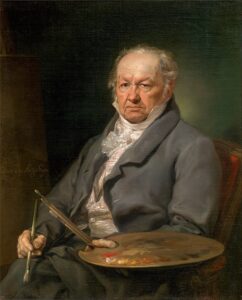
Although Goya has an extensive portfolio of romantic Spanish paintings, he did not shy away from printmaking– Globally establishing him as a reputing printmaker and even anthropologist to some for his courage to depict 18th and 19th century Spain.
The Old Masters etchings were nothing shy of Spanish influence, Romanticism, and gothic themes– emotion, isolation, horror, mystery, and power. To Begin, he was born in Fuendetodos, Spain, where he studied painting in Bordeaux, France, at the ripe age of 82.
However, during his lifetime, he somehow balanced the sorrow of losing children as a parent with a deafening illness and high esteem as a court painter for the Spanish royal monarchy.
Due to such imbalance, Goya turned inward and produced his most well-known disturbing etchings, Disasters of War and Caprichos.
Albrecht Altdorfer (1480-1538)
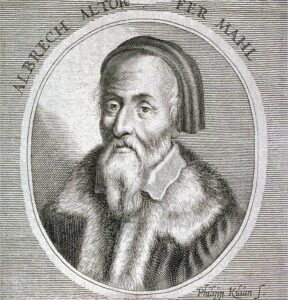
Albrecht Altdorfer was a German painter that was not shy to explore German, Bavarian, Austrian, France, and Swiss landscapes in his etchings, such as in his most famous print, Landscape with a Double Spruce and Small Source. Russian painter Dmitri Zhilinsky also inspired him.
And despite his passion for biblical scenes and historical depictions, Albrecht stands out when it comes to etching within the landscape, for he doesn’t add people inside them. Instead, his etchings distinctly specialize in dramatic twilight lighting and intricate details.
In his lifetime, Albrecht created over 36 etchings, marking the Northern Renaissance in northern Europe.
Parmigianino (1503-40)
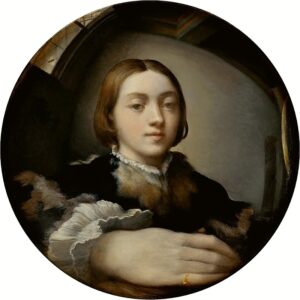
The name Parmigianino is short for Girolamo Francesco Maria Mazzola Italian painter and printmaker born in Parma, Italy. He produced his most famous prints during the Italian renaissance and mannerism eras– The Entombment Facing Right and The Lovers.
In addition, Parmigianino sought inspiration from Giovanni Jacopo Caraglio and Antonio da Trento, who commissioned him to etch and print their engravings and woodcuts. Despite the lack of classical training in intaglio printing, Parmigianino’s desire to learn deemed him the first Italian to print under the etching needle.
However, he only etched fifteen prints before his feverish death in Casalmaggiore, Italy, at the Servite Friars.
James McNeill Whistler (1834-1903)
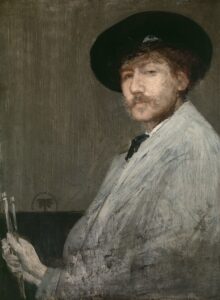
James Whistler is one of America’s most influential figures in 19th-century printmaking. Although he was born in Lowell, Massachusetts, Whistler made a name for himself as London’s own.
And despite his classical militant training at West Point’s United State Military Academy as a topographical draughtsman, he successfully employed the same technicality in printmaking. Despite his time in the military, his etches drew inspiration from his close comrades Gustave Courbet and Henri Fantin-Latour.
However, his most notable etches, such as The Doorway and The Netherlands, gently reflect the themes of aestheticism coining the nomadic sediment “art for art’s sake.”
Max Klinger (1857-1920)
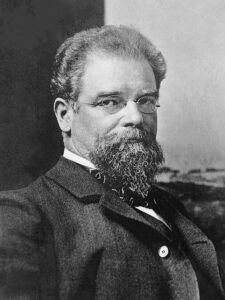
Max Klinger is another German printmaker whose most unique intaglio prints, Paraphrase on the Finding of Glove series and At the Gate, took turned Art Nouveau on its head. Although he often traveled between his home base in Berlin and studios in Paris, he found inspiration in Japanese artwork, symbolism, and the Vienna secession.
And despite developing his fondness for painting at the Karlsruhe Academy of Fine Arts, he grew a deep respect for studying etchings of Rembrandt, Durer, and Goya. So much so that he cultivate his mesmerizing style under the German underground through equally famous engraver Herman Sagert.
However, with age, Klinger distanced himself from printmaking and returned to his first love of painting and sculpture.
Famous Etching Artwork
As etching gained notoriety, it inspired the world and paved the way for new art forms to emerge into the modern art world. Today, what were once rare etchings that only elite art circles could admire are accessible through museums, online art galleries, and coffee table art books.
And inside your favorite coffee table book, you’ll probably find these famous etching artworks by beloved artists worldwide.
The Three Trees – Rembrandt, 1643
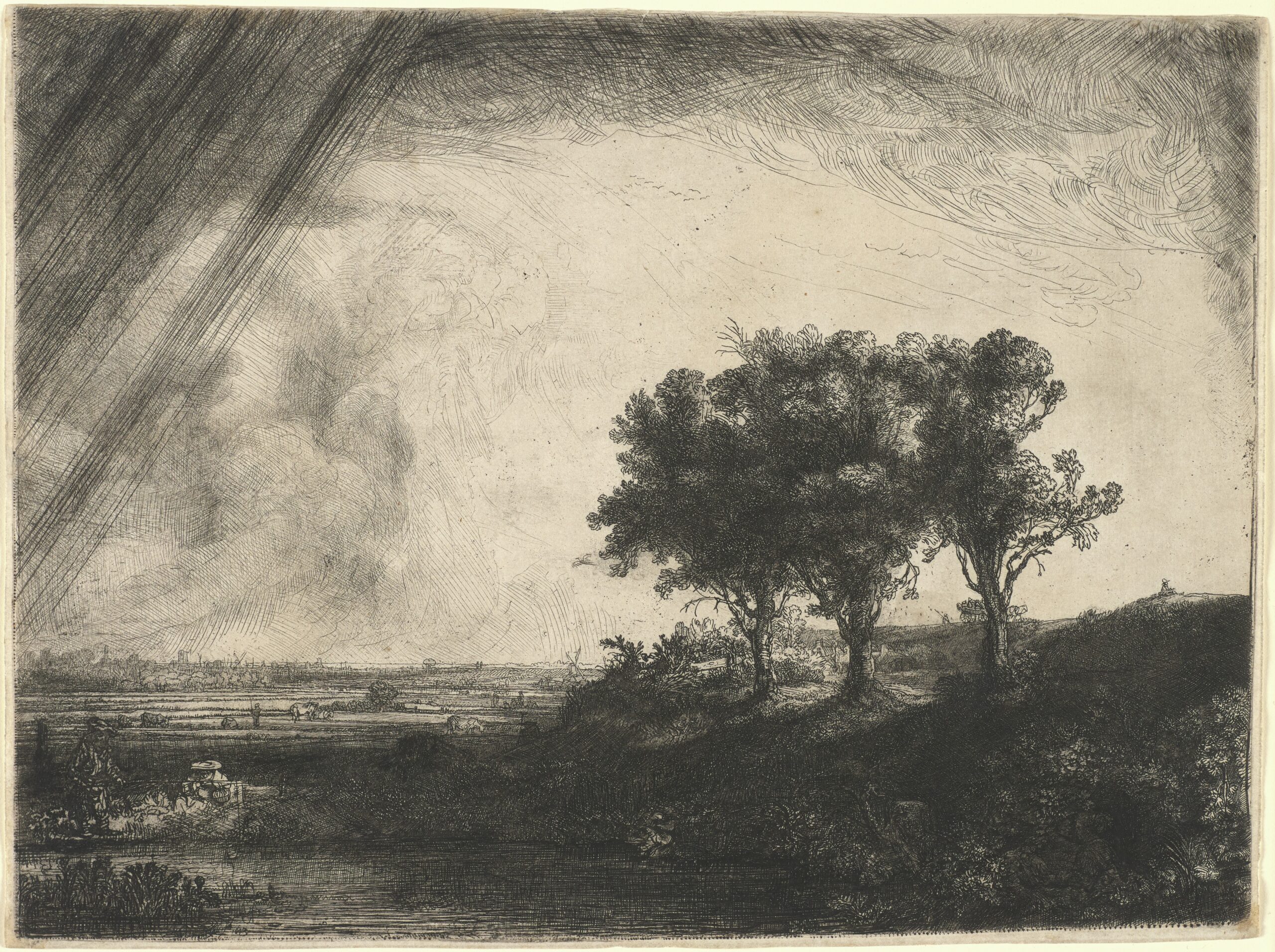
With The Three Trees etch, it is clear that Dutch artist Rembrandt was more interested in his understanding of the intaglio technique than he was in gaining international popularity. He is combining engraving with drypoint and aquatint etching.
The etch details a water-washed landscape of two couples hidden underneath brush and unusual cloud shapes that suggest that the plate may have been the sketch base for the drypoint etching of The Death of the Virgin.
- Dimensions: plate: 8 3/8 x 10 15/16 in. (21.3 x 27.8 cm)
- Sheet: 8 3/8 x 11 1/8 in. (21.3 x 28.3 cm)
- Mount: 14 1/4 x 19 1/4 in. (36.2 x 48.9 cm)
Hundred Guilder Print – Rembrandt, 1649
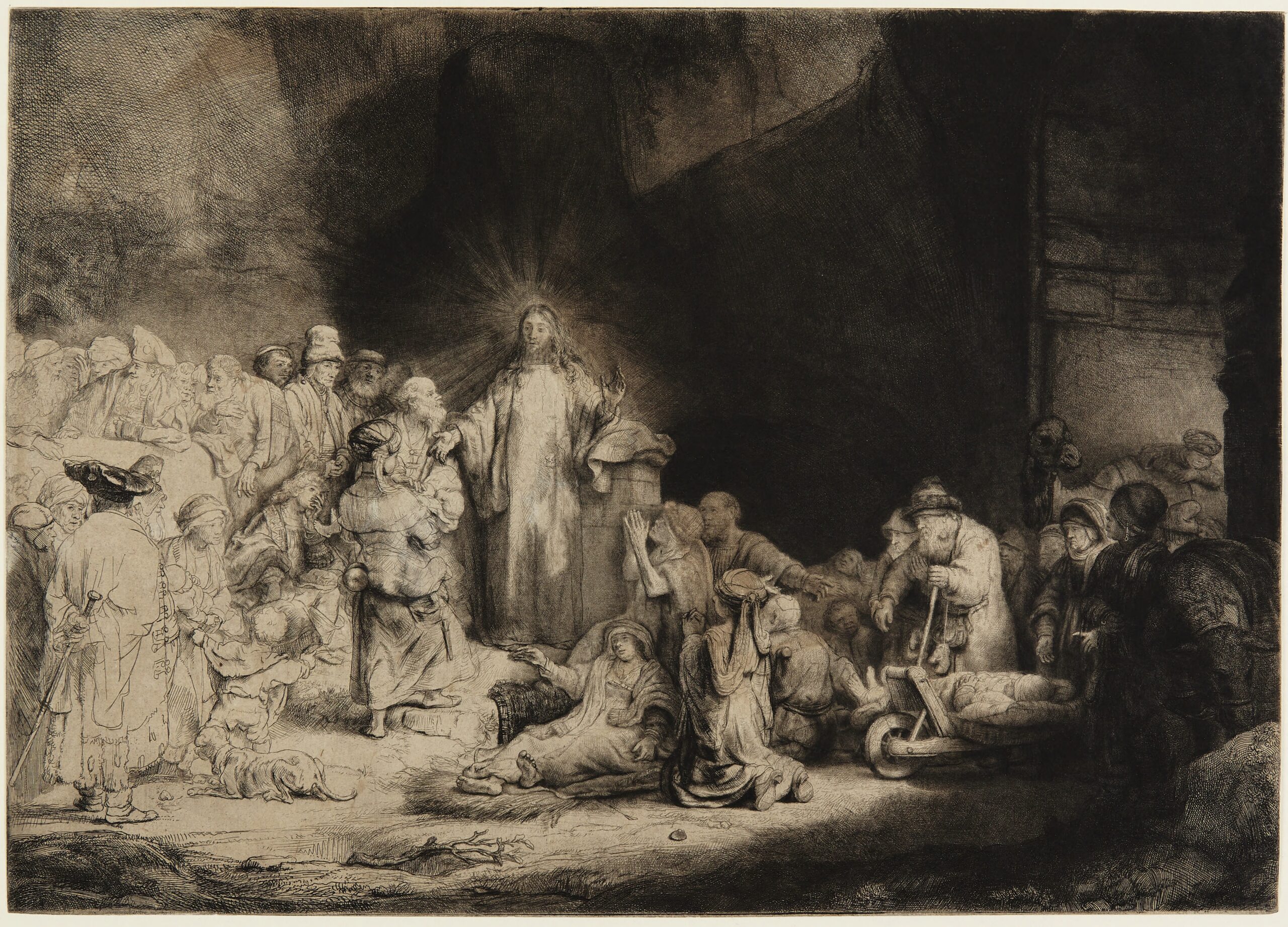
The Hundred Guilder Print demonstrates Rembrandt’s ability to blend complex techniques with celestial beauty to capture this particular print of this biblical chapter of the powerful Gospel of St. Matthew. The print eloquently guides your interests between contrasting dark and light etches until your eyes meet with the luminosity of Christ.
However, the title has mostly nothing to do with the gospel. Instead, it is a testament to Rembrandt’s overwhelming intimate attachment to the print, describing how he paid a hundred guilders to purchase the impression back to himself. However, the validity is the buy-back remains a tale tested against time.
- Dimensions: plate: 11 x 15 1/2 in. (28 x 39.3 cm)
Knight, Death and the Devil – Albrecht Dürer, 1513
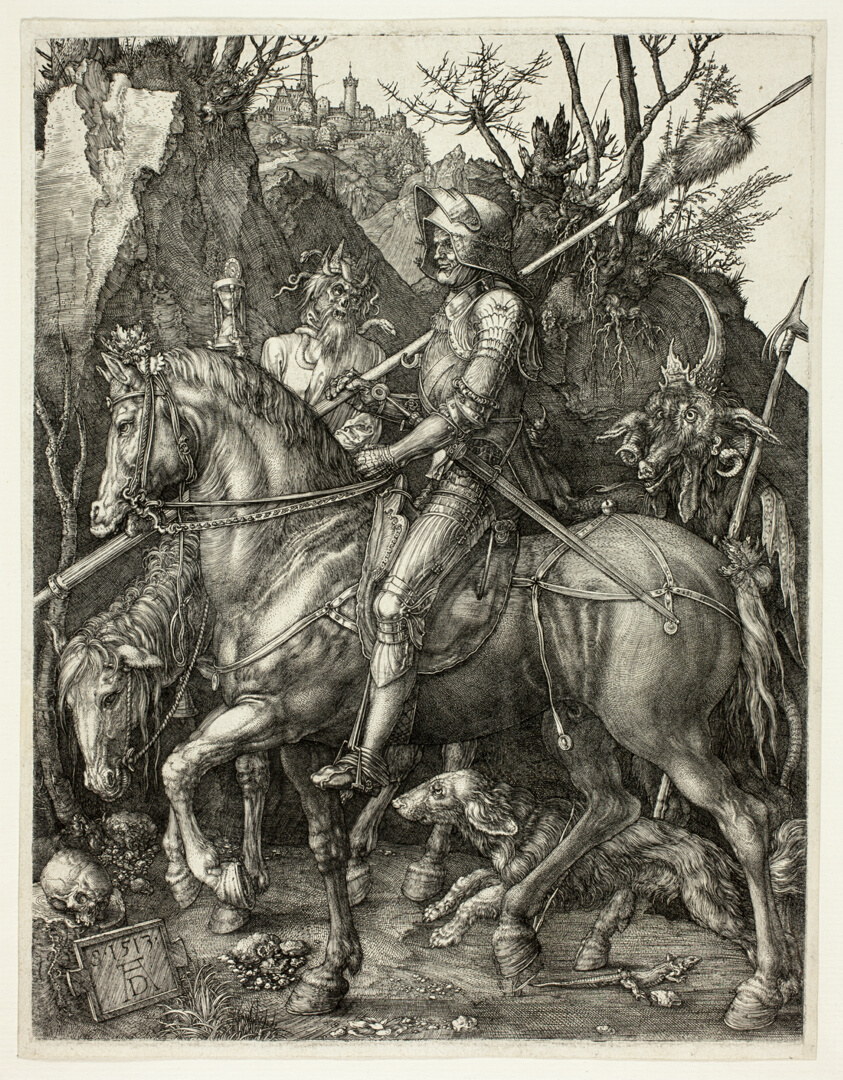
While most prints are relatively small, the Knight, Death, and the Devil is reasonably large, deeming the three-piece print an iconic representation of the limits of mortality. Combining themes of deteriorating death with an uncontrollable yet aging demonic timeline plagued with skeletons, bearing the burden of war that Christian soldiers must carry.
Although the print is dark and dreary, it reflects the popular goth period of the Northern Renaissance era. And he seamlessly blends the age of European discovery and conquest with the reality of venturing into new worlds– that it was the ultimate test of faith, morality, and logic challenging Dutch philosopher and Catholic priest Erasmus’ Handbook of a Christian Knight.
- Dimensions: Sheet: 9 13/16 x 7 11/16 in. (25 x 19.6 cm)
- Plate: 9 9/16 x 7 3/8 in. (24.3 x 18.8 cm)
Self-Portrait, Reflection, Lucian Freud, 2004
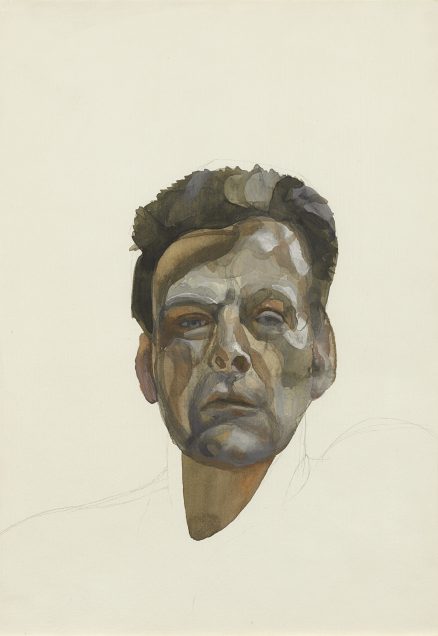
Although Berlin painter Lucian Freud is most renowned for his impact on 20th-century realism paintings, his life-sized Self-Portrait etch. The print is relatively dark from head to shoulder.
However, he does incorporate bright white spaces around his face that perhaps highlight how he’s aged softly despite his ripe old age at the time of etching.
After many prints of trial and error, attempting to capture a perfectly bitten print, Freud settle on one in collaboration with award-winning British printmaker Marc Balakjian at Studio Prints. The chosen self-portrait to Queen Elizabeth 2 per request of the Order of Merit portrait series in honor of meritorious service towards the advancement of the art in 1996.
- Dimensions: Sheet: 88.4 x 70.4 cm
The Virgin seated on a cloud, Federico Barocci, 1584
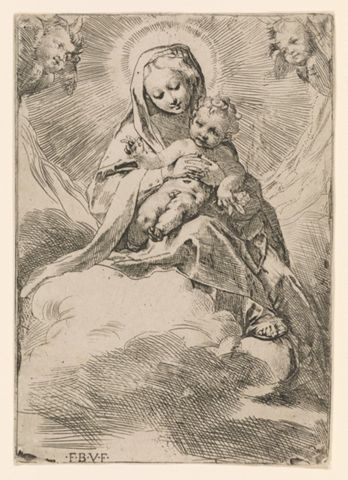
The Virgin seated on a cloud is one of four rare prints that Barocci used to describe the Virgin’sVirgin’s angelic luminosity. At the same time, she embraces the baby Christ and thick yet varietal etch marks, blending, contrasting, engraving, and printmaking techniques.
He also inspired other Italian artists that still needed to become familiar with intaglio printmaking. And his prints even reached the famous Rembrandt, which recreated several of his prints.
- Dimensions: sheet: 6 x 4 7/16 in. (15.2 x 11.3 cm)
Conclusion
Despite modern modes of printmaking that take the role of digital newspapers or ebooks, etching will live on forever as the godfather of printmaking techniques, as the same principles still apply today.
Some of us may create an original image with an apple pen or a mouse, while others pay homage to greats with the metal plate and etching needle, ready for print and repeat.
